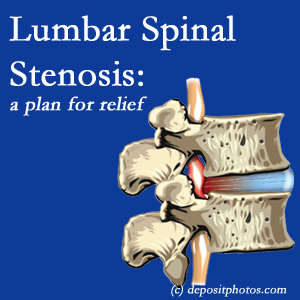
LUMBAR SPINAL STENOSIS: What do to?
Lumbar spinal stenosis (LSS) is seemingly
one of the most common spinal conditions in the US, impacting
more than 500 million people over the age of 62. (1)
As researchers grapple with a more systematic approach
to managing patient care for lumbar spinal stenosis sufferers,
your McHenry chiropractor provides gentle, safe, relieving treatment. The latest effort
at a system underscored that each LSS patient is
unique in his/her presentation
which limits any algorithm to be “soft guidance” as to its treatment
plan based initially on the LSS patient's pain relief in
spinal flexion. (2) Since spinal stenosis is characteristically
a systemic issue, which means that if you have spinal stenosis in
the lumbar spine, you likely have it in other spinal areas like the cervical as
well, you don’t want to overlook it. Further,
lumbar spinal stenosis is not a condition that appears and
disappears forever. Its pain can be managed, but it’s often “chronic,”
meaning it lasts beyond 90 days. Be hopeful! OrthoIllinois Chiropractic is experienced in ways to help with lumbar spinal stenosis relief. One study reported
that flexion distraction significantly reduced pain and
disability for lumbar spinal stenosis patients. (3) Another study reported
that chronic back pain sufferers with moderate to severe symptoms got better
the most with the chiropractic technique, Cox® Technic Flexion Distraction
Decompression (CTFDD), compared with physical therapy. (4) Those same patients had
significantly lower pain scores over the following 12 months than did
patients who did physical therapy. (5) LSS patients also have
altered gait and balance issues. (1,6) CTFDD helps these issues,
too! A study about the influence of spinal manipulation on
balance issues in LSS patients explained that flexion
distraction spinal manipulation improved function, symptoms, and
performance-based mobility in patients with lumbar spinal stenosis. (6) We also
look forward to the outcomes of a prospective data collection
study in its second year of follow-up with patients who were treated
with CTFDD for relief of their LSS-related back
pain. Data collection will be done later this year with findings being published in the years to come. McHenry
lumbar spinal stenosis is everywhere, and its relieving partner is your
McHenry chiropractor here at OrthoIllinois Chiropractic!
Listen to this PODCAST
with Dr. Dean Greenwood on The Back Doctors Podcast with Dr. Michael Johnson
as he explains his relieving treatment of a spinal
stenosis patient with The Cox® Technic System of Spinal Pain
Management.

TIP OF THE MONTH: Stretch, Strengthen, Walk for LSS
Improvement
As a set of researchers sets up
a new study to see if a 6-week education and exercise
program will enhanced the walking capacity of lumbar spinal
stenosis patients with neurogenic claudication (7), we} recommend walking and exercising
now! Lots of research shows
that lumbar spinal stenosis responds to exercise. A study showed
that individualized exercise (stretches and strengthening) mixed with manual therapy (like out CTFDD spinal manipulation
mobilization!) beat medical care and group exercise with more
symptom and function improvement as well as walking capacity at 2 months of
care. (8) OrthoIllinois Chiropractic has just the program of stretching, strengthening, and
manipulation for you! We will set it up together!
CONTACT OrthoIllinois Chiropractic
We appreciate all of our patients
here at OrthoIllinois Chiropractic and look forward to a healthy 2023! Set
your next McHenry chiropractic appointment with
OrthoIllinois Chiropractic soon to keep your
spine in great shape. See you then!
"This information and website content is not intended to diagnose, guarantee results, or recommend specific treatment or activity. It is designed to educate and inform only. Please consult your physician for a thorough examination leading to a diagnosis and well-planned treatment strategy. See more details on the
DISCLAIMER page. Content is reviewed by
Dr. James M. Cox I."